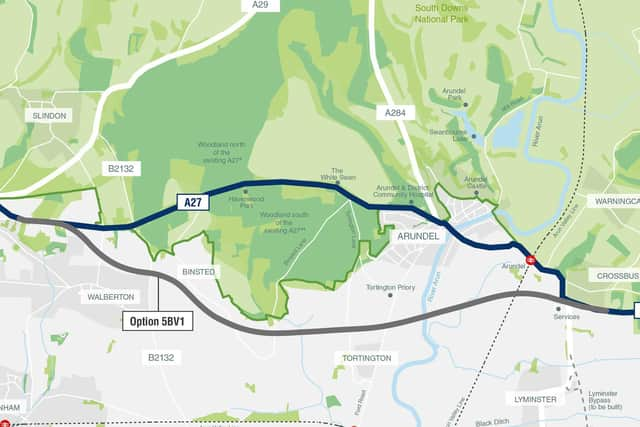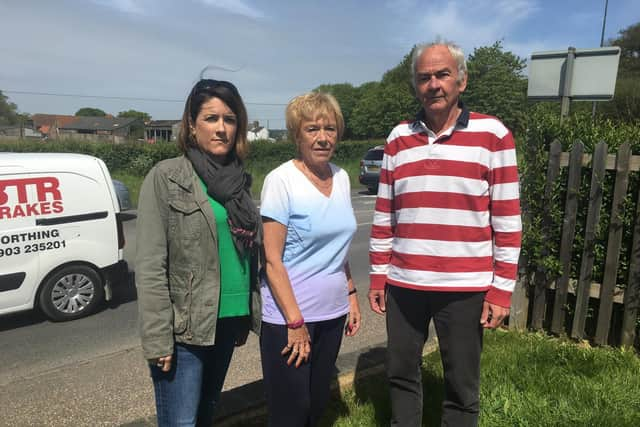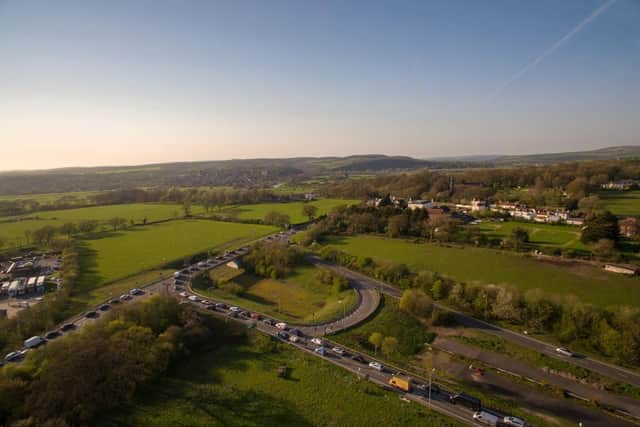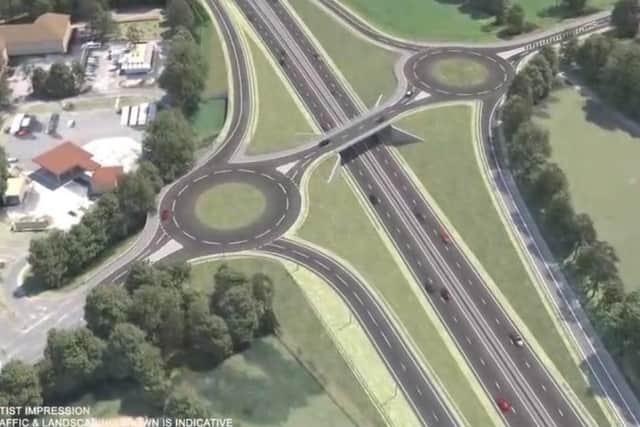Arundel Bypass: everything you need to know about the new route
and live on Freeview channel 276
Last year, it put forward six colour-labelled options for the A27 bypass that the public could have their say on. Thousands responded to the consultation, and today (October 15) Highways announced that the 'grey route' has been picked as the one it will be hoping to build.
What is the 'grey option'?
This route, shown in the video above, sweeps south of the South Downs National Park and includes a new dual carriageway between Crossbush in the east and a new junction near Tye Lane in the west.
Advertisement
Hide AdAdvertisement
Hide AdIt is the longest and costliest of the six routes put forward, estimated by Highways last year at £320 to £455million, cuts through the least amount of woodland - 1.49 hectares, compared to 20.57 for the most impactful option - and is the only option not to pass through at least part of the national park.
It would also save the most driving time: six to 11 minutes per journey, Highways previously estimated. It is expected to deliver benefits for 60 years.
But it will heavily impact the villages of Binsted, Walberton and Tortington, which have fought against bypass plans for years. The new road would cut through Binsted Valley, passing close to the village’s 12th Century church, natural wetlands and a rare chalk stream, campaigners said.
Environmental campaigners have also been extremely vocal in opposing any bypass.
Advertisement
Hide AdAdvertisement
Hide Ad

Both Arun District Council and West Sussex County Council originally backed the 'magenta route' option, which was similar to the grey route but went through ancient woodland and the South Downs National Park and went through more of Binsted than Walberton.
What benefits does Highways England claim a 'grey' bypass will bring for drivers?
Aside from the reduced journey times, Highways England said it will:
Make journeys safer - the A27 at Arundel has an above average collision rate. In the five-year period January 1, 2013 to December 31, 2017, 81 personal injury collisions, resulting in 121 casualties, were recorded between Crossbush junction to the east and the Fontwell (East) junction to the west.
Advertisement
Hide AdAdvertisement
Hide Ad

Reduce congestion – the existing A27 through Arundel is operating at up to 150% capacity, with around 21,000 vehicles using the A27 through on a daily basis, this is predicted to increase to 26,300 by 2041.
Support economic growth – businesses across the region will benefit from efficiencies and improved journey times, while the additional capacity will enable the authorities to better manage population growth.
How has West Sussex reacted?
For residents of Binsted, Walberton and Tortington, this is the worst-case scenario.


On Twitter, Binstead Village said: "Horrific for Binsted, Walberton and Tortington. ‘Avoids the National Park’ but will wipe out our village completely. Binsted Rife Valley, trashed. St Mary’s Church, almost 1000 years old, utterly ruined. We are desperate."
Advertisement
Hide AdAdvertisement
Hide AdIt added: "Grey route is so bad we thought they’d never go for it."
Extinction Rebellion Chichester replied: "Madness, cruel devastating madness. Time to lie down in front of so called progress."
Suzanne Clark, chairman of Walberton Parish Council, said it was the 'worst possible option' for the villages.
Emma Tristram from Binsted, who previously blocked bypass plans with a High Court challenge, felt Highways England had ‘ignored public opinion’ as ‘only seven per cent of responders voted for [grey] in the public consultation’. “A majority of the responders – 64% – wanted Beige or Cyan [routes that followed the current path of the A27] or ‘do nothing’”, she said.
Advertisement
Hide AdAdvertisement
Hide AdIn contrast, The Woodland Trust said it was 'delighted threatened ancient woodland has had a reprieve' and Arundel mayor Tony Hunt, speaking on behalf of Arundel Town Council, welcomed the news as it would stop drivers ‘rat-running’ through the town centre.


Environmental campaigners are also not happy. The countryside charity CPRE Sussex said it was 'appalled' by the news and the Arundel SCATE community group said it wanted all bypass plans to be scrapped.
Politicans have also spoken out following the news. Andrew Griffith, Conservative MP for Arundel & South Downs, supported the project but was disappointed alternative routes that had less impact on the villages had been 'blocked'. He said he was 'committed to supporting residents in getting the best noise mitigation, road design and, where appropriate, swift compensation'.
Paul Marshall, Conservative leader of West Sussex County Council, said he would also be lobbying Government for support for the residents affected and the council would now examine the reason for this decision.
Advertisement
Hide AdAdvertisement
Hide AdDr James Walsh, Lib Dem leader of Arun District Council, backed the plans, saying it was 'a crucial part of the A27 major national and regional south coast route, of crucial importance to business, tourists, and residents'.
This was echoed by the Transport for the South East partnership of business leaders and local Government figures, which welcomed the news as it would aid the South East's economic growth.
How has Highways England responded to concerns?
Jason Hones is programme leader for the Arundel Bypass. Since the public had its say on the six options last year, which has informed Highways' decision, the pandemic struck - leading to a massive fall in the amount of cars on the roads and an increase in working from home which could have a long-term impact.
In response, Mr Hones said: "Coronavirus hasn't really impacted on our decision-making as it will be a relatively short-term blip when we are designing a road with benefits for 60 years.
Advertisement
Hide AdAdvertisement
Hide Ad"In the future, people will be using hybrid and electric cars and with the forecasted growth in the area, the road still needs to exist."
Concerns were also raised about how the project would be funded, given that the last budget figure was still around half of the £455million top estimate. Mr Hones said they were not announcing an updated cost for the project because they were in the ‘final throes’ of commercial negotiations, but Highways England had ‘rebalanced’ its entire national investment strategy to make sure it was fully funded internally.
Walberton Parish Council said Highways' announcement had not addressed the impact the bypass would have on Walberton & Binsted C Of E Primary School in The Street, Walberton. Mr Hones acknowledged 'each route option had its pros and cons, there was no clear out and out, slam-dunk decision' but they had 'taken all the potential impacts into account'.
Binsted resident Emma Tristram previously mounted a legal challenge to the bypass which led Highways England to go back to the drawing board over the reliability of its data.
Advertisement
Hide AdAdvertisement
Hide AdWhen asked whether these plans would be robust enough to withstand any legal challenges Mr Hones said: "I would like to reassure your readers that we have done the utmost to make sure this is completely above board. Our decision-making has been open and transparent, and wholly defensible.
"We believe this is the long-term best option for reducing the problem of congestion, now and in the future, for Arundel."
What is the time frame of the next stage of the project?
Now a route has been chosen, Highways England will work with stakeholders and those impacted by the 'grey route' to fine-tune the design and flesh it out. In about a year, this finalised design will again be put out to the public for consultation. From here, the plans will go to the Planning Inspectorate for consent. Pending this approval, which they aimed to get in 2023 or 2024, work could begin soon afterwards.
A potted recent history of the bypass
Plans for a bypass in Arundel have been on the cards in various guises for decades. This announcement feels like deja-vu, as in 2018, following a public consultation of three routes, Highways England announced plans to build ‘option 5a’. But it was challenged legally by Emma Tristram on the grounds that traffic data used in the consultation was out-of-date and information in the brochure was misleading. The High Court was set to make a decision on this, but Highways England announced it would be going back to the drawing board after new information came to light. The consultation on six new routes took place last year, and it seemed the ‘magenta’ route was the favourite. But the South Downs National Park, a key stakeholder, refused to back any of the options – a factor in favour of ‘grey’ being chosen.
Here is the reaction in full:
Advertisement
Hide AdAdvertisement
Hide AdEmma Tristram, secretary of the Arundel Bypass Neighbourhood Committee and Binsted resident: “ABNC was shocked to hear that Highways England has announced that the grey route is its new preferred route. This is a long, expensive monstrosity which not only ruins the villages of Tortington and Binsted, but also seriously encroaches on Walberton village. It would also destroy rare wildlife (such as the bats and dormice that forage from Binsted Woods into the Binsted valley, and the wildlife in the wet valley itself which is a rare habitat). It would cut off areas south of Arundel from the national park and affect the experience of the park itself.
“This devastating loss of beautiful countryside is the wrong response to traffic problems in the time of Covid-19 and the climate and biodiversity crisis.
“Only seven per cent of responders voted for it in the public consultation. A majority of the responders (64 percent) wanted Beige or Cyan [routes that followed the current path of the A27] or ‘Do nothing’. Highways England has decided to ignore public opinion. The possibilities of legal action against this decision are being looked into, but it may be up to the Planning Inspector to decide whether Highways England’s case for the road scheme outweighs its unpopularity with the public.”
The Woodland Trust campaigner Nicole Hillier: “Nature is a necessity, not a luxury. Choosing the grey route means no irreplaceable ancient woodland – our rarest and most precious habitat - will be lost, which is a significant step forward. Infrastructure projects aimed at boosting the economy must always work alongside nature and ancient woodland, not against it.
Advertisement
Hide AdAdvertisement
Hide Ad“Investment needs to help us reduce our impact on nature and climate, not threaten it further. We are therefore welcoming today’s announcement as real progress, but the route chosen will still result in the loss of and damage to a small number of veteran trees, meaning there is still a net loss to the environment and we will continue to impress on Highways England the value of retaining these as a solution to climate change and havens for wildlife.
“While this option is a win for ancient woodland, it does not alter the fact road building schemes are not a sustainable transport solution but we are delighted that Highways England at last appears to have listened to our concerns and that of thousands of our supporters when it comes to this precious natural resource.”
Suzanne Clark, chairman of Walberton Parish Council, said: "Walberton Parish Council, which consists of Walberton, Binsted and Fontwell, is extremely disappointed at Highways England’s announcement of the A27 Arundel Bypass preferred route as being the grey option.
"How strange that our Parish with over 2,200 residents, who are likely to be the most affected by this choice, was not given any warning of this announcement by Highways England even though we are a key stakeholder.
Advertisement
Hide AdAdvertisement
Hide Ad